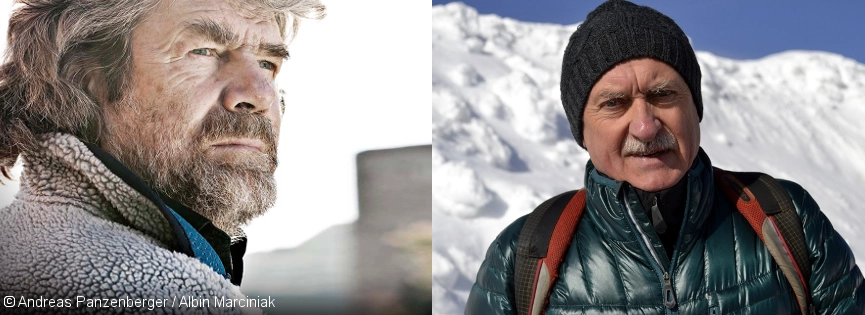Main content
Reinhold Messner and Krzysztof Wielicki 2018 Princess of Asturias Award for Sports

Via their sporting careers, Reinhold Messner and Krzysztof Wielicki embody the essence of mountaineering, a sport in which both, through their numerous expeditions to the Himalayas, have accomplished great feats and have marked new milestones, becoming an example and inspiration for new generations of climbers.
Reinhold Messner (Funes, Bolzano, Italy, 17th September 1944), with his ascent to Lhotse in 1986, became the first man to conquer the 14 summits of more than eight thousand metres that exist on the planet. His first eight-thousander was Nanga Parbat in 1970 (which he ascended again in 1978). This was followed by Manaslu (1972), Hidden Peak/Gasherbrum I (1975 and 1984), Everest (without oxygen in 1978 and solo in 1980), K-2 (without oxygen, 1979), Sishapangma (1981), Kangchenjunga (1982), Gasherbrum II (1982 and 1984), Broad Peak (1982), Cho Oyu (1983), Annapurna (1985), Dhaulagiri (1985) and Makalu (1986), until he crowned Lhotse that same year, thereby conquering his fourteenth eight-thousander. He was commissioned to take one of the first photographs of the mummy known as “the Iceman”, found in a Similaun snowdrift, in the border area between Italy and Austria in 1991. Messner has also crossed Antarctica (1991-1992), the Taklamakan Desert in Bhutan, Greenland (1993) and the Gobi Desert (2004).
Between 1999 and 2004, he was a Member of the European Parliament for The Greens. He has written some fifty books, translated into a dozen languages, and participates in the making of documentaries. He was the founder of Mountain Wilderness, an NGO dedicated to the conservation of natural areas and, through the Messner Mountain Foundation, helps the inhabitants of mountainous areas around the world. He has also launched the Messner Mountain Museum, a project he has called his “fifteenth eight-thousander”, dedicated to the history of mountaineering. Headquartered in Bozen, in the Italian Tyrol, it has five other branches in the region.
Krzysztof Wielicki (Szklarka Przygodzicka, Poland, 1950) first took up mountaineering at 14 years of age in the Tatra Mountains, in his native Poland. Acknowledged as one of the most outstanding mountain climbers in the world and a symbol of Polish mountaineering, Wielicki’s name is associated in the world of mountaineering with historical milestones such as having been the fifth man in the world to have conquered the planet’s 14 eight-thousanders and to having made the first ascents in winter to the summits of three mountains of over eight thousand metres in height: in 1980, he ascended to Mount Everest (8848 m), along with Leszek Cichy; to Kangchenjunga (8586 m) in 1986, along with Jerzy Kukuczka; and Lhotse (8516 m) solo in 1988. In 2018, he organized and led the expedition to K2 (8611 m), the only eight-thousander still to be conquered in winter, although the climb had to be suspended due to bad weather. During this attempt, Wielicki’s expedition featured in one of the so-called “Himalayan feats” in which solidarity and camaraderie emerge as the mainstays of this sport: the operation on Nanga Parbat to rescue Elisabeth Revol, whom they managed to save, and Tomek Mackiewicz, for whom they could do nothing. In 1984, Wielicki made the first ascent in a single day to an eight-thousander, crowning Broad Peak, and that same year opened up a new route to climb Manaslu. In 1993, he ascended Shisha Pangma solo via a new route.
In addition to his achievements as a climber, his sports colleagues highlight his values as a human being, his companionship and his leadership skills when faced with challenges in the mountains. At almost 70 years of age, Wielicki dedicates a large part of his time to spreading the values of mountaineering and to advising practitioners of this sport on techniques and strategies to follow in the mountains. He is the author or co-author of several books. He is a member of The Explorers Club, an international company based in New York founded in 1904 with the aim of promoting exploration and field research, and was distinguished with the Lowell Thomas Award in 2006.
End of main content
